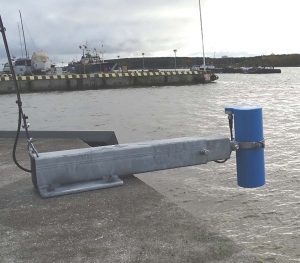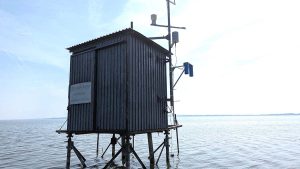
New Oil Spill Alert System Introduced to U.S. Market
Published on January 14, 2024Oil and water don’t mix. Marinas know this fact all too well either from completing EPA’s mandatory Spill Prevention Control and Countermeasure plans or from having the unfortunate task of reporting and cleaning up a spill. What if there was a way to know about a spill the moment it happens, whether someone is on-site to see it or not?
There is. Through a partnership between PhotonTec™ and LDI Innovation Ltd, two businesses with decades of experience in optical high-tech products and solutions, an LED-based fluorometric oil and fuel sensing product has launched. The new BlueHawk™ and TinyHawk™ fluorosensors hit the United States market in October, following several years of success in Europe.
Technological Advances
PhotonTec, based in Georgia, has more than 20 years of experience introducing optical technology and products to the North American market. EU-based LDI was established in 2013 as a manufacturer of optical technologies. The company holds ISO 9001:2015 certification and its customers include Petrobras, Total, NOAA, NASA, FBI, Airbus Defence and Space, MIT, Samsung, and many others.

While fluorometric sensor technology is well known, there are a limited number of companies that have applied the technology to the types of sensors LDI developed.
According to Juha Saily, business development manager for PhotonTec, “Ours are the only sensors that can operate in two different ultraviolet wavelength ranges. Wavelength ranges are A – right below visible, and B- a little further down in wavelengths. We’re the only ones doing B, which is much more sensitive and critical for lighter oil detection like gasoline. UV A works well on heavier oils like crude and lubricants,” he said.
Beyond the wavelength ranges, the BlueHawk and TinyHawk products have unique patented coaxial designs made for high sensitivity and with a high tolerance for varying surfaces such as areas with high tidal ranges or rough waters. The internal LED health monitoring system and control helps eliminate false alarms. They also come with extra-long sensing distances that range up to 33 feet and have a wide scan/installation angle of up to 45 degrees from vertical. This means the sensors can be placed on a surface like a pile and monitor a large area of a marina basin.
The sensors can also be used to detect land-based spills, an important feature for facilities that store fuel or oil in upland tanks. The alarms are an added level of safety that not only help protect the marina environment but also could be looked upon favorably by regulators who inspect USTs and review spill plans.
The tube-looking sensor is the main part of the unit. It is mounted vertically on a holder so it can look down on the water at up to a 45-degree angle. This enables it to sense contamination even if it is coming from a vessel moving around the basin. The larger BlueHawk model is about 10 inches by 4 inches, while the smaller Tiny Hawk is 3.5 inches by 4 inches, enabling it to fit in tighter areas. The two sensors monitor up to 10 feet distance and 33 feet distance respectively.

The sensor needs power like a USB charger that outputs 12 to 24 volts. If AC is needed, converters are available. The cable that’s attached to the sensor feeds the power and also contains the wires enabling remote access to the monitor and alarm transmission. The electrical signal from the sensor activates either a flashing light, audible alarm, or both. The company has also connected the sensor to a wireless modem that enables text messages to be sent if oil or fuel are detected on the water’s surface. Sensors can be hard wired as well. “They consume very little power so solar and battery operation are also possible,” Saily said.
Benefit to Marinas
Saily said marinas should start by adding a sensor to their fueling area. “A typical marina would need from six to 10 sensors to cover its entire basin.” They can be wired together as a network or placed as a standalone system.
Both fluorometric sensors emit ultraviolet light pulses onto a scanned surface. When the light interacts with hydrocarbon contamination it turns fluorescent. The sensor detects the fluorescence, measures its intensity, and initiates an alarm. Blue Hawk has coaxial optics meaning just one big lens sits inside the sensor that delivers lots of light out from the UV LED. The same lens and apertures detect reflections from the spill.
The average service life of the UV LED depends on how bright the light is and how far the sensor is placed from the water’s surface. How much stress is on the LED component is another factor. After five years the intensity of the LED drops a bit, but it still functions. The larger BlueHawk contains a second sensor inside the first while that same internal monitoring is an option in the smaller Tiny Hawk. Neither unit requires maintenance.
The sensors come with an option for Chlorophyll-A detection which is essentially algae. As marinas face challenges from issues such as red tides that block sunlight and choke off water life, an alert that algae is building could help ward off larger problems.
Minimizing those larger problems that come from both algae and oil is the very purpose of the new sensors which can become another tool for marinas to use in their efforts to reduce their environmental impact and help assure clean waters for the future.
| Categories | |
| Tags |




